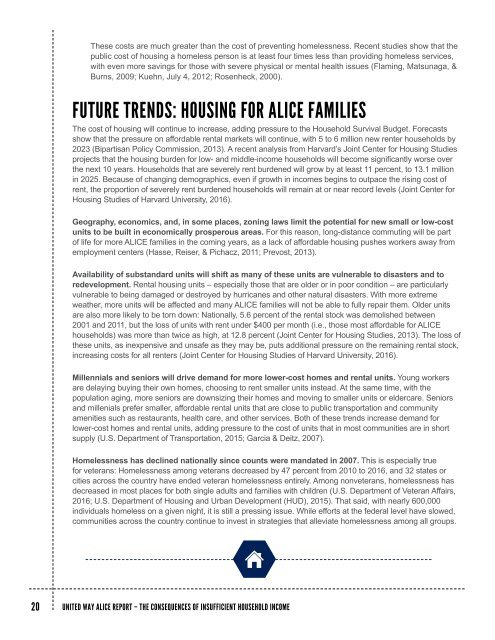The Consequences of Insufficient Household Income
This new Consequences of Insufficient Household Income report provides a deeper level of understanding of the choices that ALICE and poverty-level families across the country make when they do not have enough income or assistance to afford basic necessities, and the consequences of those choices.
This new Consequences of Insufficient Household Income report provides a deeper level of understanding of the choices that ALICE and poverty-level families across the country make when they do not have enough income or assistance to afford basic necessities, and the consequences of those choices.
You also want an ePaper? Increase the reach of your titles
YUMPU automatically turns print PDFs into web optimized ePapers that Google loves.
<strong>The</strong>se costs are much greater than the cost <strong>of</strong> preventing homelessness. Recent studies show that the<br />
public cost <strong>of</strong> housing a homeless person is at least four times less than providing homeless services,<br />
with even more savings for those with severe physical or mental health issues (Flaming, Matsunaga, &<br />
Burns, 2009; Kuehn, July 4, 2012; Rosenheck, 2000).<br />
FUTURE TRENDS: HOUSING FOR ALICE FAMILIES<br />
<strong>The</strong> cost <strong>of</strong> housing will continue to increase, adding pressure to the <strong>Household</strong> Survival Budget. Forecasts<br />
show that the pressure on affordable rental markets will continue, with 5 to 6 million new renter households by<br />
2023 (Bipartisan Policy Commission, 2013). A recent analysis from Harvard’s Joint Center for Housing Studies<br />
projects that the housing burden for low- and middle-income households will become significantly worse over<br />
the next 10 years. <strong>Household</strong>s that are severely rent burdened will grow by at least 11 percent, to 13.1 million<br />
in 2025. Because <strong>of</strong> changing demographics, even if growth in incomes begins to outpace the rising cost <strong>of</strong><br />
rent, the proportion <strong>of</strong> severely rent burdened households will remain at or near record levels (Joint Center for<br />
Housing Studies <strong>of</strong> Harvard University, 2016).<br />
Geography, economics, and, in some places, zoning laws limit the potential for new small or low-cost<br />
units to be built in economically prosperous areas. For this reason, long-distance commuting will be part<br />
<strong>of</strong> life for more ALICE families in the coming years, as a lack <strong>of</strong> affordable housing pushes workers away from<br />
employment centers (Hasse, Reiser, & Pichacz, 2011; Prevost, 2013).<br />
Availability <strong>of</strong> substandard units will shift as many <strong>of</strong> these units are vulnerable to disasters and to<br />
redevelopment. Rental housing units – especially those that are older or in poor condition – are particularly<br />
vulnerable to being damaged or destroyed by hurricanes and other natural disasters. With more extreme<br />
weather, more units will be affected and many ALICE families will not be able to fully repair them. Older units<br />
are also more likely to be torn down: Nationally, 5.6 percent <strong>of</strong> the rental stock was demolished between<br />
2001 and 2011, but the loss <strong>of</strong> units with rent under $400 per month (i.e., those most affordable for ALICE<br />
households) was more than twice as high, at 12.8 percent (Joint Center for Housing Studies, 2013). <strong>The</strong> loss <strong>of</strong><br />
these units, as inexpensive and unsafe as they may be, puts additional pressure on the remaining rental stock,<br />
increasing costs for all renters (Joint Center for Housing Studies <strong>of</strong> Harvard University, 2016).<br />
Millennials and seniors will drive demand for more lower-cost homes and rental units. Young workers<br />
are delaying buying their own homes, choosing to rent smaller units instead. At the same time, with the<br />
population aging, more seniors are downsizing their homes and moving to smaller units or eldercare. Seniors<br />
and millenials prefer smaller, affordable rental units that are close to public transportation and community<br />
amenities such as restaurants, health care, and other services. Both <strong>of</strong> these trends increase demand for<br />
lower-cost homes and rental units, adding pressure to the cost <strong>of</strong> units that in most communities are in short<br />
supply (U.S. Department <strong>of</strong> Transportation, 2015; Garcia & Deitz, 2007).<br />
Homelessness has declined nationally since counts were mandated in 2007. This is especially true<br />
for veterans: Homelessness among veterans decreased by 47 percent from 2010 to 2016, and 32 states or<br />
cities across the country have ended veteran homelessness entirely. Among nonveterans, homelessness has<br />
decreased in most places for both single adults and families with children (U.S. Department <strong>of</strong> Veteran Affairs,<br />
2016; U.S. Department <strong>of</strong> Housing and Urban Development (HUD), 2015). That said, with nearly 600,000<br />
individuals homeless on a given night, it is still a pressing issue. While efforts at the federal level have slowed,<br />
communities across the country continue to invest in strategies that alleviate homelessness among all groups.<br />
20 UNITED WAY ALICE REPORT – THE CONSEQUENCES OF INSUFFICIENT HOUSEHOLD INCOME




